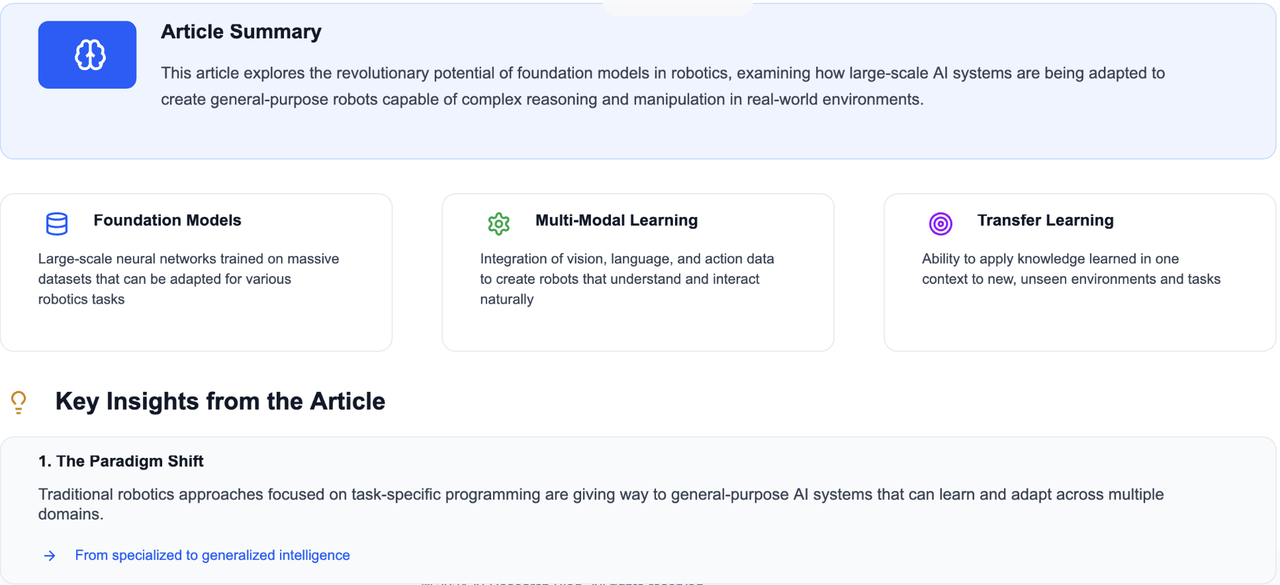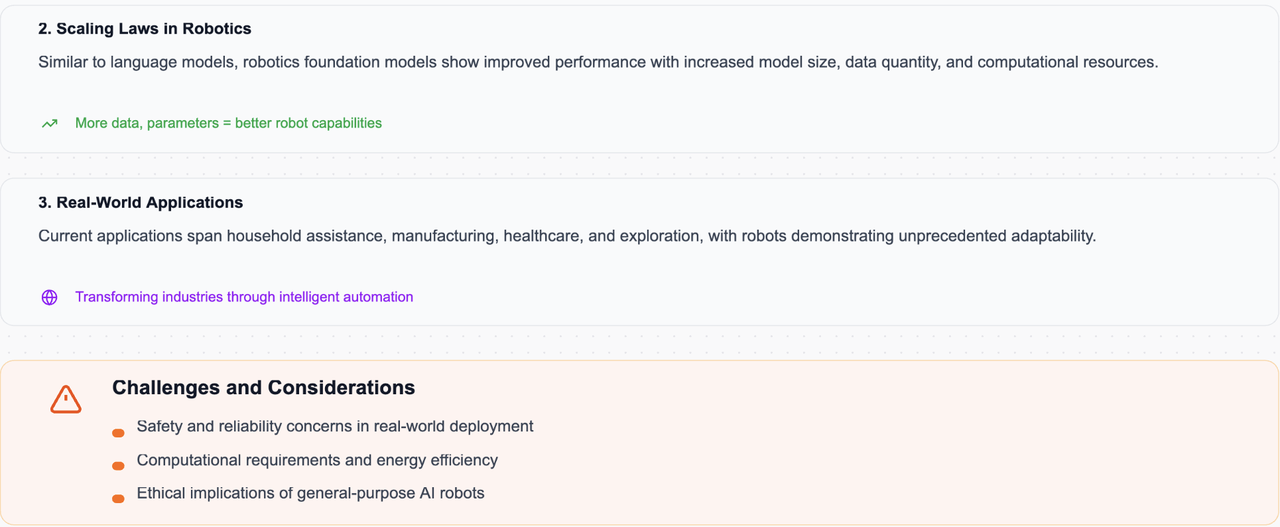Envision entering your kitchen and instructing, "Robot, prepare breakfast." The robot comprehends not only your command but also your preferences—whether you desire pancakes and coffee or toast and juice—and adapts to your kitchen layout to execute the task effectively. This scenario represents the ambitious aim behind advancing robotics foundation models.
Just as GPT revolutionized language processing and vision models transformed image recognition, robotics is poised for a similar foundation model revolution. Unlike text or images, robots must navigate a complex physical environment, making real-time decisions that affect their surroundings.
Understanding Robotics Foundation Models¶
Foundation models can be likened to the "Swiss Army knife" of artificial intelligence. In language processing, models such as GPT manage various tasks like writing, translation, and summarization from a single trained system. Robotics foundation models aspire to provide similar versatility for physical robots.
These models will be trained on extensive, diverse datasets, including:
- Robot interaction data: Extensive hours of robots performing diverse tasks
- Human demonstration videos: Learning from observing people in various activities
- Simulation environments: Virtual settings for safe practice
- Natural language descriptions: Interpreting task instructions in straightforward language
The primary distinction from current robotics methods lies in scale and generalization. Rather than programming robots for specific tasks, these foundation models will enable them to adapt to new situations and challenges, akin to how skilled individuals can cook in any kitchen.
The Two-Fold Opportunity¶
1. Revolutionary Task Specification¶
Currently, directing a robot is akin to programming in machine code—precise and inflexible. Foundation models promise a transformative shift.
The Challenge: When instructing a robot to "make breakfast," the interpretation varies. Does it mean a full American breakfast, a simple bowl of cereal, or a continental spread? Context matters significantly.
The Solution: Advanced foundation models would grasp context, preferences, and cultural subtleties. They could learn that in your home, "make breakfast" typically signifies scrambled eggs and coffee on weekdays but pancakes on weekends, derived from diverse training datasets.
Real-World Impact: Consider healthcare robots that can interpret a patient's statement of "I'm uncomfortable" and discern whether it indicates a need for a pillow adjustment or medical assistance.
2. Accelerated Task Learning¶
Conventional robot training resembles teaching someone to drive solely in one parking lot. Foundation models, however, provide comprehensive driving principles applicable across various environments.
The Power of Transfer Learning: A robot trained on foundation models could learn to "pour liquid" from numerous examples involving different containers and scenarios. When faced with pouring wine into a delicate glass, it would already understand the necessary physics, precision, and potential challenges.
Few-Shot Adaptation: Similar to how humans quickly adapt known skills to new situations, these models will empower robots to master new tasks with minimal specific training. A robot adept at folding towels could swiftly learn to fold shirts with just a few demonstrations.
The Significant Challenges¶
Data: The Foundation of Robotics¶
The primary challenge in robotics is not technological; it lies in data collection. Unlike language models that can easily gather text from the internet, robotics necessitates physical interaction data, which is costly and time-intensive to obtain.
The Scale Challenge: Training a language model like GPT involves processing billions of web pages. In contrast, training a robotics foundation model may require millions of hours of robotic operations across diverse environments. This is akin to compiling a comprehensive cookbook by preparing every dish instead of merely reading the recipes.
The Diversity Challenge: Existing datasets for robots offer limited variety, similar to a cookbook filled solely with pasta recipes. We require a diverse collection akin to a global cuisine anthology—robots operating in factories, homes, hospitals, and outdoor settings, managing tasks from delicate electronics to heavy machinery.
Innovative Solutions: Researchers are investigating creative strategies:
- Simulation Scaling: Developing virtual environments where robots can safely practice countless scenarios.
- Human Video Learning: Training robots by analyzing videos of humans performing various tasks on platforms like YouTube.
- Distributed Learning: Establishing networks of robots that share experiences in real-time.
Safety: The Distinction of the Physical World¶
When a language model makes an error, the outcome is often awkward text. However, when a robot errs, it can result in injury or property damage.
Real-World Risks: Unlike digital AI systems, robots operate in the physical realm, where mistakes can have serious consequences. For example, a robot learning to cook must have safeguards to prevent fires, cuts, or food contamination.
The Adaptation Challenge: When robots enter new environments, how can we ensure their behavior remains safe while allowing for learning and adaptation? This scenario is similar to allowing a teenager to drive in a new city—they need the freedom to navigate, but within safe parameters.
Safety-First Strategies: Researchers are working on:
- Constrained Learning Environments: Controlled kitchens where nothing can break or cause harm.
- Automatic Reset Mechanisms: Robots equipped to reverse their mistakes.
- Formal Safety Guarantees: Mathematical assurances that robots will not exceed safety limits.
The Multimodal Advantage¶
Robotics foundation models are particularly promising due to their inherently multimodal nature. Unlike language models that focus mainly on text, or vision models that deal exclusively with images, robotics models must integrate:
- Visual Perception: The ability to comprehend visual input.
- Language Comprehension: Following verbal or written instructions.
- Physical Interaction: Skill in manipulating objects.
- Spatial Reasoning: Navigating three-dimensional spaces.
- Temporal Understanding: Sequencing actions over time.
This integration more closely resembles human intelligence than any prior AI system. Humans simultaneously see, hear, and move; robotics foundation models strive to replicate this unified intelligence.
Looking Ahead: A Realistic Timeline¶
While the vision is inspiring, we remain in the early stages. Current research is concentrated on:
Near-Term (2-5 years):
- Enhanced data collection techniques.
- Improved transfer from simulation to real-world applications.
- Specialized foundation models for specific sectors, such as kitchen robotics or warehouse automation.
Medium-Term (5-10 years):
- Development of general-purpose household robots equipped with foundation model capabilities.
- Establishment of robust safety frameworks for real-world implementation.
- Integration with existing smart home technologies.
Long-Term (10+ years):
- Creation of truly general-purpose robots that match human adaptability.
- Seamless collaboration between humans and robots in complex environments.
- Widespread adoption across various industries and households.
The Collaborative Future¶
The advancement of robotics foundation models requires unprecedented collaboration among:
- AI Researchers: Developing the underlying algorithms.
- Robotics Engineers: Constructing the physical systems.
- Safety Experts: Ensuring responsible deployment.
- Domain Specialists: From healthcare, manufacturing, and other sectors.
- Ethicists and Policymakers: Addressing societal implications.
Conclusion: Developing Tomorrow's Robot Companions¶
Robotics foundation models represent one of the most ambitious AI initiatives of our time—creating artificial intelligence that can think, comprehend, and operate in the physical world with human-like adaptability. While the obstacles are significant, the potential benefits are transformative.
Achieving success means developing robots that serve as true partners rather than mere tools—capable of understanding our needs, adapting to our environments, and assisting us in unprecedented ways. From elder care to space exploration, and from household assistance to disaster response, general-purpose robots could significantly alter our way of life and work.
The path to this future involves overcoming fundamental challenges in data collection, safety, and multimodal learning. However, with each breakthrough, we progress toward a reality where robots are not just programmable machines but intelligent, adaptable partners in human endeavors.
The future of robotics transcends merely building superior robots; it encompasses creating robots that can self-improve, learn continuously, and adapt to meet humanity's evolving needs. This future is closer than we may realize.
Citation: Bommasani, R., Hudson, D. A., Adeli, E., Altman, R., Arora, S., von Arx, S., ... & Liang, P. (2022). On the opportunities and risks of foundation models. arXiv preprint arXiv:2108.07258. Available at: https://arxiv.org/abs/2108.07258

